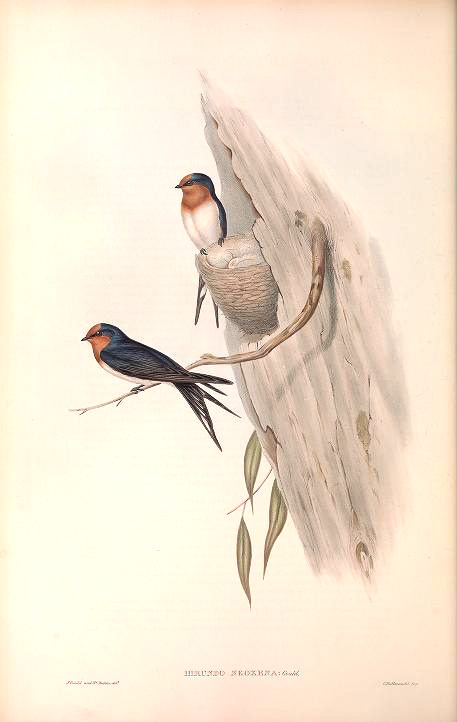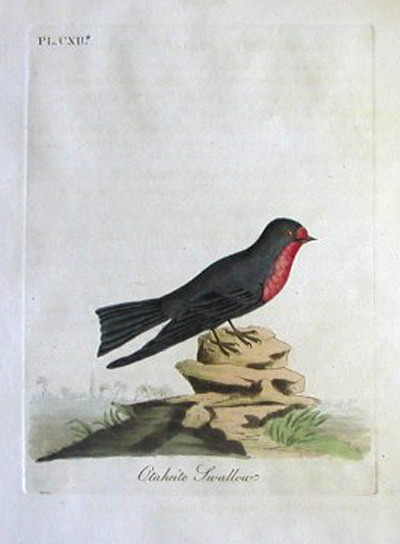


Warou, the welcome swallow from John Gould's, Birds of Australia, 1840–48.
The Warou, welcome, or house swallow, was self introduced from Australia in the 1950s so it is categorised as a fully protected native bird. The spread of the swallow has been spectacular and they are now a very common bird throughout the country. As well as Australasia, the bird breeds in Southern Asia from India to Malaysia and the western Pacific.
They are small, graceful, dark blue and white birds, with variable amounts of rusty red on the head and breast. They have streamlined bodies with a short neck and long, pointed wings. The tail is a deeply forked “swallowtail”. Their flight is graceful and rapid as they hawk for insects on the wing. They are birds of open country, hunting over lakes, rivers and grassland and are often seen perching on power lines like so many clothes pegs.
Around here they are in competition with Piwakawaka, the fantail, which also enjoys the myriad of insects to be found around the river. They seem to live happily enough together, although expert thinking says that no two species can occupy the same ecological niche without the demise of one. By my observations, it seems the fantail is better able to cope with winter and the violent storms we often have around here by its ability to use safe roosting places.
The Australian bird, like its European counterpart, is migratory. Indeed it is thought that during its yearly migration to and from Tasmania, the birds were blown off course by storms and so ended up here. The welcome swallow shows no signs of being migratory here in New Zealand.
The European swallows are regarded as harbingers of spring and the ancient Greeks had festivals to welcome their arrival. The proverb, “one swallow does not a summer make”, is a pretty near literal translation of an ancient Greek proverb. In the ancient world, the birds were particularly associated with the household gods and their presence was looked upon as fortuitous. Conversely, any harm done to them could bode evil for the household.
— Narena Olliver, Waiotahi Valley, 1999.


Image from John Latham's, General Sysnopsis of Birds, 1795.
| Taxonomy | |
|---|---|
| Kingdom: | Animalia. |
| Phylum: | Chordata. |
| Class: | Aves. |
| Order: | Passeriformes. |
| Family: | Hirundinidae. |
| Genera: | Hirundo. |
| Species: | tahitica. |
| Sub Species: | neoxena |
house swallow, pacific swallow
Native bird
15 cm., 14 g., graceful, dark blue and white, variable amounts of rusty red on the head and breast. They have streamlined bodies with a short neck and long, pointed wings. The tail is a deeply forked “swallowtail”.
Widespread but more common in the warmer northern North Island.
Warou, the welcome swallow
LINK to Nest Page
Gould, Birds of Australia, 1840–48.
Latham, John, General Sysnopsis of Birds, 1795.
Heather, B., & Robertson, H., Field Guide to the Birds of New Zealand, 2000.
Oliver, W.R.B., New Zealand Birds, 1955.
Wednesday, 23 August, 2023; ver2023v1